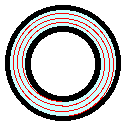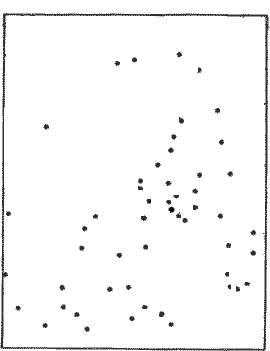Disorder, Entropy, and Couette
Flow
Ever since the statistical interpretation of
entropy became popular, more than a century ago, students have been
taught that entropy tends to favor a state of greater disorder over a
more ordered state, and that the inevitable increase in the entropy,
or disorder, of the universe provides a direction for time.
A typical example is found in Richard Feynman's
discussion of irreversibility [The Feynman
Lectures on Physics,Vol. I, 46-7], where
he uses italics to emphasize:
"It is the change from an ordered
arrangement to a disordered arrangement which is the source of the
irreversibility."
The truth of this sort of statement hinges on a
proper understanding of what is meant by
"a
disordered arrangement," a meaning that may not be obvious to a na´ve
reader and is not always clarified (Feynman does address it
several paragraphs later, see answer below).
|
One approach to a proper understanding of
order and disorder is to consider a scientific parlor trick
(one that is often analogized to spin- or optical-echo
experiments). The demonstration involves
Couette
flow of a viscous liquid in the
space between two coaxial cylinders.
|

Click to see
the whole experiment (2 meg)
|

Cross Section
|
On the right is the first frame from a
movie showing the spreading of a yellow dye in a viscous
liquid (shown blue in the cross section on the
left). The liquid is held between a
stationary interior rod and a rotatable glass
tube.
In the movie the outside tube is rotated
to the left by three complete turns, 3 x 360░ =
1080░ (note black reference line)
and then rotated back again.
Click
to download the QuickTime movie (0.9
meg)
|
Compare the last frame of the movie
to the first frame. Only the time on the watch has
changed.
(The watch proves that there has been no software
hankypanky.)
|
At first this seems quite surprising.
Because the liquid appears uniformly yellow after rotation, it is
natural to assume that the dye has been randomly and uniformly
mixed throughout the liquid. "Unmixing" should be impossible, as
is pointed out by the 13-year-old prodigy Thomasina to her tutor
Septimus in Tom Stoppard's 1993 play "Arcadia":
|
THOMASINA: When you stir your rice
pudding, Septimus, the spoonful of jam spreads itself
round making red trails like the picture of a meteor in
my astronomical atlas. But if you stir backward, the jam
will not come together again. Indeed, the pudding does
not notice and continues to turn pink just as before. Do
you think this is odd?
SEPTIMUS: No.
THOMASINA: Well, I do. You cannot stir
things apart.
SEPTIMUS: No more you can, time must
needs run backward, and since it will not, we must stir
our way onward mixing as we go, disorder out of disorder
into disorder until pink is complete, unchanging and
unchangeable, and we are done with it for
ever.
|

Cross Section after 1080░ rotation
|
In fact the flow of the viscous liquid is, to a first approximation, laminar and without turbulence, inertial flow, or
diffusion. The amount of angular displacement of any bit of
liquid depends only on its distance from the axis of the
cylinders. The liquid has been cleanly sheared.
Bits of liquid next to the rotating outer
cylinder rotate with it by 1080░, while those next to
the stationary inner cylinder do not rotate at all. After
three cycles of rotation the dye forms a thin sheet wound
three times around the cylinder axis (as shown by the red
line in the cross section at the left). Viewed from the
side, the dye appears to be evenly distributed, because from that perspective we
cannot perceive the pattern.
Reversing the rotation "unwinds" the
spiral sheet back into the original line.
[Of course this kind of non-turbulent
"mixing" does accelerate true dissolution by shortening
the distances that need to be covered by randomizing
diffusion, but diffusion in a liquid as viscous as corn
syrup is very slow.]
|
What fooled us was the appearance of randomness after
1080░ rotation. The dye was just as ordered after rotation as
it was before, but in a less easily perceived way.
|
This Couette flow demonstration makes us
cautious about supposing that an arrangement is random or
"disordered" just by the look of it. What appears to be
disordered may truly be ordered but in a very complicated
way.
Of course one can arbitrarily define some
quantitative measure of the randomness of a distribution
(e.g. the fractal dimension), but different individuals
could choose different measures.
In fact any arrangement at all might
be considered "ordered" by someone.
Compare the two sets of 52 dots in the
frames to the right. Most individuals would think of the
second arrangement as rather disordered, but you can
click
here to see that the second is also highly
ordered.
|

|

|
If any arrangement may be considered ordered -
if order is in the eye of the beholder - the concept of "a disordered
arrangement" is an oxymoron and dangerous to use in a fundamental
theory.
|
What did Feynman mean by
saying,
"It is the change from an ordered
arrangement to a disordered arrangement
which is the source of the
irreversibility."
|
|
After thinking about this riddle for
a while, click
here for the
answer.
|
References
Reversible Couette Flow as a model of spin
and optical echos is discussed by R. G. Brewer and E. L. Hahn, in
"Atomic Memory", Scientific American, 251, No. 6, pp.
50-57 (December, 1984) [thanks to Victor Batista
for this reference]
For a more physical description of the Couette unmixing experiment
see John P. Heller "An Unmixing Demonstration," American Journal
of Physics, 28, 348-353 (1960).
Tom Stoppard, "Arcadia", Faber and Faber, Boston, 1993. Act I,
Scene 1. [Thanks to J. D. Dunitz for pointing out
this passage.]
Dinosaur connect-the-dots from http://www.lizardpoint.com/fun/java/dinodots/dino1.html
Thanks to Angelo Gavezzotti, Kurt Zilm, and John Tully for
helpful comments.
copyright 2002
J.M.McBride

